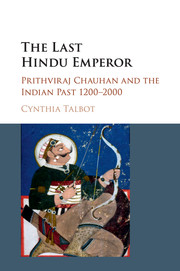Book contents
- The Last Hindu Emperor
- The Last Hindu Emperor
- Copyright page
- Contents
- Illustrations
- Acknowledgements
- Note on transliteration and citation
- Abbreviations
- 1 Introduction: layers of memory
- 2 Literary trajectories of the historic king
- 3 Delhi in the making of the last Hindu emperor
- 4 The heroic vision of an elite regional epic
- 5 Imagining the Rajput past in Mughal-era Mewar
- 6 Validating Pṛthvīrāj Rāso in colonial India, 1820s–1870s
- 7 Contested meanings in a nationalist age, 1880s–1940s
- 8 Epilogue: the postcolonial Prithviraj
- Appendix Pṛthvīrāj Rāso’s textual history
- Bibliography
- Index
- References
Bibliography
Published online by Cambridge University Press: 05 December 2015
- The Last Hindu Emperor
- The Last Hindu Emperor
- Copyright page
- Contents
- Illustrations
- Acknowledgements
- Note on transliteration and citation
- Abbreviations
- 1 Introduction: layers of memory
- 2 Literary trajectories of the historic king
- 3 Delhi in the making of the last Hindu emperor
- 4 The heroic vision of an elite regional epic
- 5 Imagining the Rajput past in Mughal-era Mewar
- 6 Validating Pṛthvīrāj Rāso in colonial India, 1820s–1870s
- 7 Contested meanings in a nationalist age, 1880s–1940s
- 8 Epilogue: the postcolonial Prithviraj
- Appendix Pṛthvīrāj Rāso’s textual history
- Bibliography
- Index
- References
- Type
- Chapter
- Information
- The Last Hindu EmperorPrithviraj Chauhan and the Indian Past, 1200–2000, pp. 291 - 311Publisher: Cambridge University PressPrint publication year: 2015



